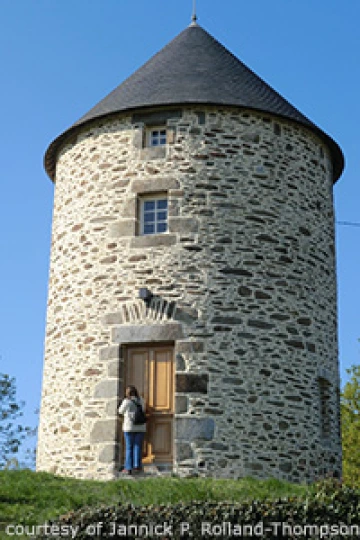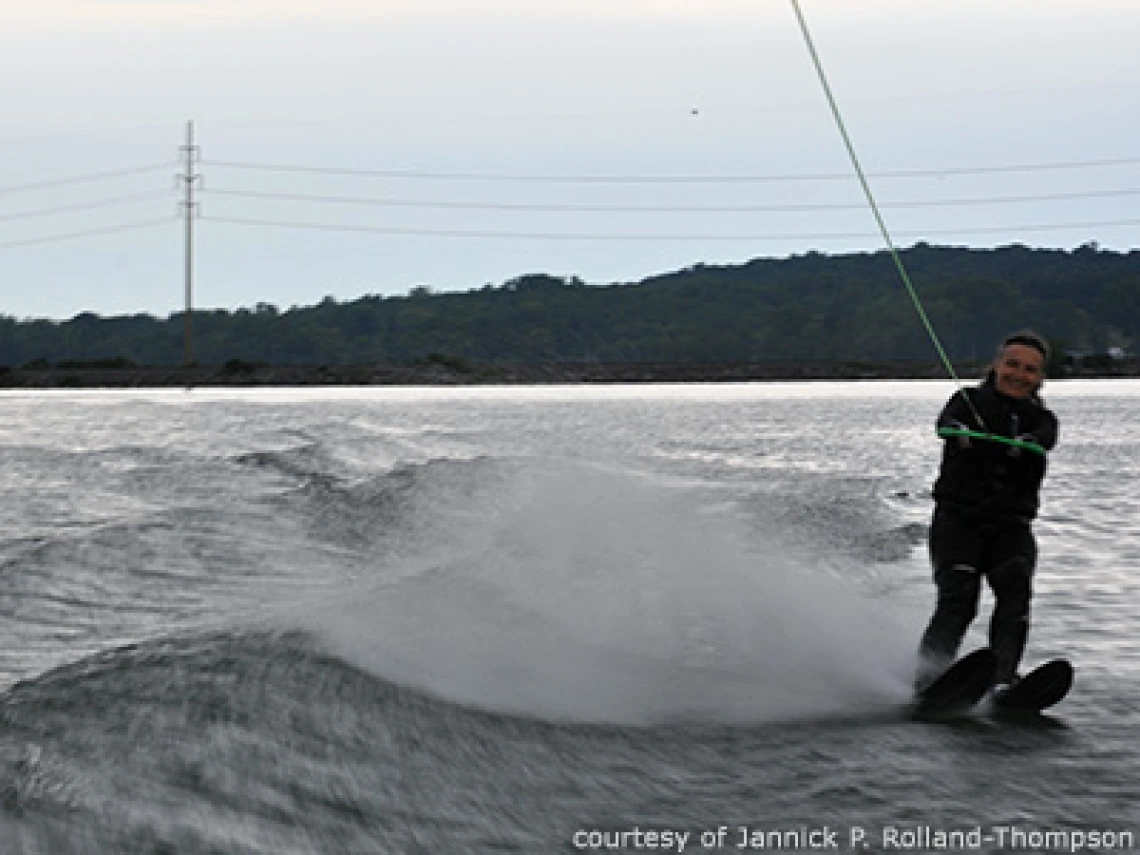Etendue: Jannick P. Rolland-Thompson
Welcome to Etendue, featuring interesting and accomplished individuals known for their leadership and contributions both with their careers and the College of Optical Sciences, in their own words. (For a similar view on the college’s best and brightest – our students – please check out Another Wavelength among our Students in the Spotlight.)
This week, we hear from Jannick P. Rolland-Thompson, Ph.D. 1990.
Where are you from?
I grew up near Paris, France, and in French Brittany, where my family is from. I completed high school in 1978 with a specialty in math and physics. As a teenager, I was eager to live my life independently, so I worked very hard to graduate a year early. After high school I was accepted into the prestigious Classes Préparatoires in Paris but I declined because I wanted more of a physics-heavy education (I was a bit of a physics obsessive) with extensive hands-on experience. I decided to enroll in IUT Mesures Physiques in nearby Orsay instead. As valedictorian of the IUT, I was admitted at the Ecole Superieure d’Optique, also in Orsay, by professor and director Michel Cagnet and graduated with a master's in optical engineering in 1984 with some solid background in optical system design and aberration theory. I moved to Tucson, Arizona, to become fluent in English and chose to pursue a Ph.D. at the Optical Sciences Center with professor Harry Barrett in medical instrumentation – a best-ever decision along my career path, to work with Harry, a mastermind at mathematics and physics combined. Tucson was both a spiritual and intellectual awakening for me; I received my Ph.D. in 1990.

Who or what influenced your interest in optics?
Indirectly my father planted the seed in me at a young age to become an engineer. As he restored the family house in French Brittany, I volunteered always to be his helper, and he enjoyed including me whenever possible. I was naturally attracted to building things and my father used to call me “his son” (I was the youngest of three sisters). At 16, I went to see a play in Versailles, France, with my mother. The only thing I remember is being totally amazed by the special effects and lighting. As we exited the theater, I told my mother I wanted to get involved in technology to create 3-D special effects. That theatre visit opened up my curiosity and made me want to create technology. One more side to the puzzle – at the IUT Mesures Physiques, my optics professor, Jacques Ser, used to jump up and down from one side of the room to the other to imitate the wave propagation; he was so passionate about optics it was contagious. Optics was abstract and felt somewhat like magic, a little harder than electronics or computer science, and closer to what I may need to create light and sound special effects. I wanted to learn more about waves, and optics was the specialty to do so. There was no Internet back then, so my strategies to break into the optical world, once time had come to select a major, were very direct. I went in person to the Lycée Fresnel in Paris, where the concierge let me know the Ecole Superieure d’Optique that used to be co-located there had moved to Orsay, where I was already studying physics. While living in Paris was a little bit of a dream, I decided to stay in Orsay to get involved in the world of optics.
Describe your career.
I started my career as a postdoctoral fellow in computer science at the University of North Carolina, Chapel Hill, in 1990, where I designed my first head-worn display for medical visualization – a perfect marriage for my background. Amidst creative peers, I developed an interest in computer graphics and human vision and had the opportunity to lead the vision group from 1992 to 1996. In the mid-1990s, I joined CREOL in Orlando, Florida, as assistant professor, and created the ODALab, working on augmented reality that combined optics, computer science and human vision. I received tenure and the rank of associate professor in early 2000 and full professor in 2007. In between, I spent a full-year sabbatical in Paris with my two sons, Yvan, age 11, and Roman, age 9 (they became fluent in French after a year abroad – mission accomplished), and started a collaboration then with the Institut d'Optique that lasts to this day. In 2009, the vision to take the technology my team and I had developed into the clinic combined with the need to work closer with optics manufacturers led me to join the Institute of Optics at the University of Rochester. I was humbled to be endowed as the Brian J. Thompson Professor of Optical Engineering that spring.
Both Thompsons (while unrelated) were my good stars that year, as it is in 2009 as well that Kevin Thompson, Ph.D. 1980, and I married. Still driven to create a compact head-worn display with high performance, I started exploring in 2007 designing optics with freeform surfaces of various kinds. Early discoveries in design and aberration theory led me, together with some of my colleagues in Rochester, to launch the National Science Foundation Industry/University Cooperative Research Center for Freeform Optics by 2013. I was also offered the opportunity in 2012 to lead the Robert E. Hopkins Center for Optical System Design and Engineering for which I was asked to develop a viable business model for sustainability – I cared and added this mission to an already very full set of commitments. Both centers focus on enhancing the education of graduate and undergraduate students alike through research collaboration across university partners, the industry and government labs – which speaks to me in profound ways. As all these responsibilities unfolded, I became also more acutely aware and driven to translate technology from the lab to the outside world. As a result, in 2013, I co-founded LighTopTech with Dr. Cristina Canavesi (my first graduated Ph.D. student from Rochester, who also received an MBA in 2015), with a vision to translate the innovation in 3-D optical imaging we had developed into enabling technologies across fields of applications in manufacturing and medical. The hard work never stops but each stage is its own rewarding journey.

Describe your current job.
With my students at the University of Rochester and colleagues at LighTopTech, we work often long hours, driven in my case by the beauty I find in mathematics and the innovation in hardware and algorithms that enables new science and discovery. We invest many hours in disseminating broadly through writing and sharing with the global community, which comes with traveling the world and developing diverse friendships along the way. Being a scientist comes with hard work but also flexibility. I work to integrate time outdoors, in particular swimming in Hawaii a couple of months a year; water skiing and wake-surfing on the Finger Lakes in New York, where we now live to facilitate that process; and hiking in French Brittany near our recently renovated windmill cabin – a creative project in itself – all with Kevin Thompson with whom I have come to share our lives, and our two sons Yvan (22, who just graduated with a B.S in computer science from NYU and the Stern School of Business) and Roman (20, rising junior at Stony Brook University who started in physics but recently pivoted to computer science), who inspire us every day with their infinite energy, self-drive, and young innovative spirit.
Share your single best OSC experience.
I will never forget the warm welcome of professor Jack Gaskill and his wise advice as I arrived at the Optical Sciences Center in 1984. We had long discussions about the Ph.D. program and how it might impact my future, and to this day I am extremely grateful of his mentorship and encouragement as I was starting out. We developed a special greeting that we use to this day, “jus d’orange,” that Jack found difficult to pronounce and sought strategies to improve upon, which roughly translates to “orange juice.” Thanks, Jack, for caring so much about each one of us.
Why is staying involved with OSC important to you? How are you involved?
I have enjoyed continuing to work with Professor Barrett’s circle of students and graduates on collaborative research between our institutions. I feel that my education at the Optical Sciences Center was stellar and giving back to honor my mentors as well as support the next generation of optical engineers is part of the journey I choose. The OSC 50th anniversary celebration in Old Tucson was a great way to meet at once with several of my mentors and many friends. [Editor's note: Jannick and her husband, Kevin, were significant leaders in the establishment of four FoTO scholarship endowments at the college – one of which Jannick and Kevin funded on their own and named for her mentor, Michel Cagnet.]
Name one neat fact about you.
From a young age to my early 20s, I was a talented dancer. I was uncertain whether to launch my career as an engineer or as a professional dancer. Dancing felt good but science satisfied my craving for intellectual discovery. My time in Tucson solved this dilemma.
Photos from top: windmill cabin renovated in French Britanny; Rolland-Thompson water skiing on the Finger Lakes.
